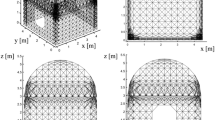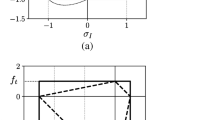Abstract
In this paper, the problem of identifying the optimal amount of composite reinforcement for a given masonry structure and its optimal dislocation over the structure is addressed through the set-up of a topology optimum problem. The topological optimization theory was originally developed for searching the equilibrium path of 3D solids under sets of applied loads. The main outcome of the topology process consisted of the identification of the optimal shape of the structure resisting the given active forces. The observation of an extreme variation and a high degree of arbitrariness in selecting the refurbishment shapes in technical and experimental tests executed on masonry structures gave birth to the original idea developed by the authors of applying the topology optimization’s fundamentals to the field of FRP and FRCM refurbishment of masonry structures. The idea is essentially based on the principle that a tensile composite strip/sheet is required to work only in the areas of the masonry solid where the tensile stress cannot be avoided. If no tensile stress arises in a region of the structure, then the adoption of the reinforcement is not needed in that area since the intervention would certainly be uneconomic in this case, and it might also produce some damage to the global stability of the structure.
Similar content being viewed by others
References
Heyman, J.: The Stone Skeleton: Structural Engineering of Masonry Architecture, pp. 160. Cambridge University Press, Cambridge (1995)
Kooharian, A.: Limit analysis of voussoir (segmental) and concrete arches. J. Am. Concr. Inst. 24, 317–328 (1952)
Baratta, A., Corbi, I., Corbi, O.: Analytical formulation of generalized incremental theorems for 2D no-tension solids. J. Acta Mech. 226(9), 2849–2859 (2015)
Baratta, A., Corbi, I.: Analysis of masonry panels using the no-tension approach. In: Civil-Comp Proceedings, 93, 2010, 10th International Conference on Computational Structures Technology, CST 2010, 14–17 Sept 2010, Valencia (2010)
Baratta, A., Corbi, I., Corbi, O.: Stability of evolutionary brittle-tension 2D solids with heterogeneous resistance. J. Comput. Struct. 174, 133–138 (2016)
Corbi, I., Corbi, O.: Analysis of bi-dimensional solids with internal unilateral constraint coupled to structural elements with different degree of connection. J. Acta Mech. 228(2), 607–616 (2016)
Corbi, I., Corbi, O.: Theorems for masonry solids with brittle time-decaying tensile limit strength. J. Acta Mech. 228(3), 837–849 (2017)
Baratta, A., Corbi, O.: Contribution of the fill to the static behaviour of arched masonry structures: theoretical formulation. Acta Mech. 225(1), 53–66 (2014)
Baratta, A., Corbi, O.: Heterogeneously resistant elastic-brittle solids under multi-axial stress: fundamental postulates and bounding theorems. J. Acta Mech. 226(6), 2077–2087 (2015)
Furtmüller, T., Adam, C.: Numerical modeling of the in-plane behavior of historical brick masonry walls. J. Acta Mech. 221(1–2), 65–77 (2011)
Ivorra, S., Pallarès, F.J.: Dynamic investigations on a masonry bell tower. Eng. Struct. 28(5), 660–667 (2006)
Khludnev, A.M., Kovtunenko, V.A.: Analysis of cracks in solids. WIT-Press, Southampton (2000)
Yi, T., Moon, F.L., Leon, R.T., Kahn, L.F.: Lateral load tests on a two-story unreinforced masonry building. J. Struct. Eng. 132(5), 643–652 (2006)
Vintzileou, E.: Testing historic masonry elements and/or building models. J. Geotech. Geol. Earthq. Eng. 34, 267–307 (2014)
Baratta, A., Corbi, I., Corbi, O.: Bounds on the elastic brittle solution in bodies reinforced with FRP/FRCM composite provisions. J. Compos. Part B Eng. 68, 230–236 (2015)
Elmalich, D., Rabinovitch, O.: Nonlinear analysis of masonry arches strengthened with composite materials. J. Eng. Mech. 136(8), 996–1005 (2010)
Mrozek, M., Mrozek, D., Wawrzynek, A.: Numerical analysis of selection of the most effective configuration of CFRP composites reinforcement of masonry specimens. J. Compos. Part B Eng. 70, 189–200 (2015)
Baratta, A., Corbi, I.: Topology optimization for reinforcement of no-tension structures. J. Acta Mech. 225(3), 663–678 (2014)
Olhoff, N., Taylor, J.E.: On structural optimization. J. Appl. Mech. 50, 1134–1151 (1983)
Bendsøe, M.P.: Optimization of Structural Topology, Shape, and Material. Springer, Heidelberg (1995)
Bendsøe, M.P., Guades, J.M., Haber, R.B., Pedersen, P., Taylor, J.E.: An analytical model to predict optimal material properties in the context of optimal structural design. J. Appl. Mech. 61, 930–937 (1994)
Olhoff, N., Lurie, K.A., Cherkaev, A.V., Fedorov, A.: Sliding regimes of anisotropy in optimal design of vibrating axisymmetric plates. Int. J. Solids Struct. 17(10), 931–948 (1981)
Eschenauer, H.A., Kobelev, V., Schumacher, A.: Bubble method of topology and shape optimization of structures. J. Struct. Optim. 8, 42–51 (1994)
Baratta, A., Corbi, I., Corbi, O.: Algorithm design of an hybrid system embedding influence of soil for dynamic vibration control. J. Soil Dyn. Earthq. Eng. 74, 79–88 (2015)
Mazza, F., Vulcano, A.: Equivalent viscous damping for displacement-based seismic design of hysteretic damped braces for retrofitting framed buildings. Bull. Earthq. Eng. 12(6), 2797–2819 (2014)
Mazza, F.: Comparative study of the seismic response of RC framed buildings retrofitted using modern techniques. Earthq. Struct. 9(1), 29–48 (2015)
Author information
Authors and Affiliations
Corresponding author
Additional information
Publisher's Note
Springer Nature remains neutral with regard to jurisdictional claims in published maps and institutional affiliations.
Rights and permissions
About this article
Cite this article
Corbi, I., Corbi, O. Combinational optimization for shaping discrete tensile boost elements in continuum structures. Acta Mech 229, 3575–3584 (2018). https://doi.org/10.1007/s00707-018-2184-5
Received:
Revised:
Published:
Issue Date:
DOI: https://doi.org/10.1007/s00707-018-2184-5




